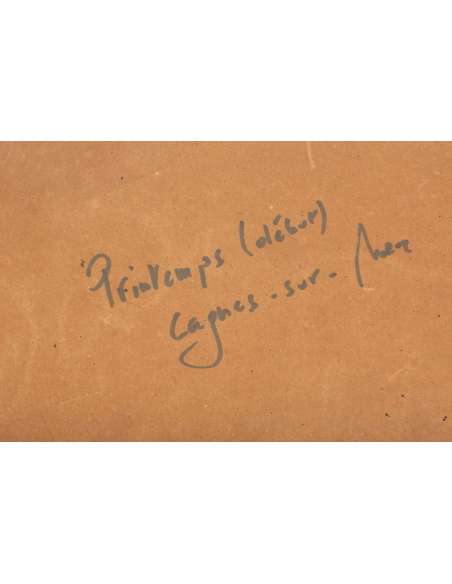"Early Spring near Cagnes sur Mer" by Georges Moullade is a masterful representation of the early spring landscape on the French Riviera. The painting captures the delicate beauty of the season with a soft, vibrant palette and expressive brushwork. Moullade's ability to convey the freshness of spring and the peacefulness of the natural environment is evident in this work.
The painting "Early Spring near Cagnes sur Mer" by Georges Moullade captures the serene beauty of a landscape during the early springtime. The scene is set near Cagnes sur Mer, a town on the French Riviera known for its picturesque landscapes and mild climate. The composition centers on a cluster of trees, situated near a water body, which dominates the scene. The trees, with their budding branches, are depicted in a state of early bloom, signaling the arrival of spring. The foreground is characterized by grasses and reeds that gently lead the viewer's eye towards the reflective water below, possibly a stream or pond. The background fades softly, allowing the pastel tones of the sky and distant landscape to provide a gentle contrast to the more vibrant foreground. In the background, one can see the city of Cagnes up on the hill.
Moullade employs a soft yet vibrant colour palette, typical of the Post-Impressionist style. The trees are depicted in shades of pink, yellow, and blue, capturing the delicate hues of early spring foliage. The sky, painted in a pale blue, serves as a calm backdrop that contrasts with the warmer colors of the trees and the sunlit grasses. The light in the painting is diffused, suggesting a clear, mild day typical of early spring in the Mediterranean region. The atmosphere is serene, with the light subtly enhancing the colors and creating a harmonious blend that evokes the freshness and renewal associated with spring. The reflections in the water add depth and continuity to the scene, mirroring the trees and sky above.
Moullade’s brushwork is loose and expressive, capturing the essence of the landscape with quick, short strokes. This technique adds texture and movement to the painting, particularly in the depiction of the trees and grasses. The water is rendered with smoother, more fluid strokes, reflecting the calmness of the scene. The influence of Impressionism is evident in Moullade’s approach to capturing light and color. However, his structured composition and the careful blending of tones align more closely with Post-Impressionism, where there is a greater emphasis on form and the emotional resonance of the landscape.
The painting is encased in a richly ornate gilded frame that enhances its visual appeal also complements the painting’s subject. The gold tones of the frame harmonize with the warm colors within the painting, creating a cohesive and luxurious presentation. The frame, with its elaborate floral motifs and scrollwork, is reminiscent of the Rococo revival style, popular in the late 19th and early 20th centuries.






















